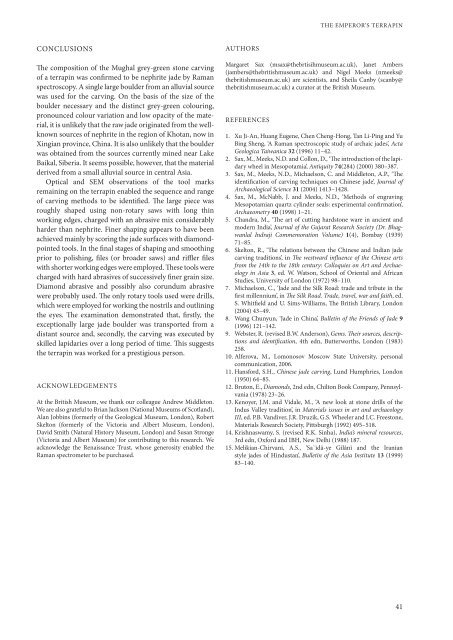The emperor's terrapin - British Museum
The emperor's terrapin - British Museum
The emperor's terrapin - British Museum
You also want an ePaper? Increase the reach of your titles
YUMPU automatically turns print PDFs into web optimized ePapers that Google loves.
CONCLUSIONS<br />
Th e composition of the Mughal grey-green stone carving<br />
of a <strong>terrapin</strong> was confi rmed to be nephrite jade by Raman<br />
spectroscopy. A single large boulder from an alluvial source<br />
was used for the carving. On the basis of the size of the<br />
boulder necessary and the distinct grey-green colouring,<br />
pronounced colour variation and low opacity of the material,<br />
it is unlikely that the raw jade originated from the wellknown<br />
sources of nephrite in the region of Khotan, now in<br />
Xingian province, China. It is also unlikely that the boulder<br />
was obtained from the sources currently mined near Lake<br />
Baikal, Siberia. It seems possible, however, that the material<br />
derived from a small alluvial source in central Asia.<br />
Optical and SEM observations of the tool marks<br />
remaining on the <strong>terrapin</strong> enabled the sequence and range<br />
of carving methods to be identifi ed. Th e large piece was<br />
roughly shaped using non-rotary saws with long thin<br />
working edges, charged with an abrasive mix considerably<br />
harder than nephrite. Finer shaping appears to have been<br />
achieved mainly by scoring the jade surfaces with diamondpointed<br />
tools. In the fi nal stages of shaping and smoothing<br />
prior to polishing, fi les (or broader saws) and riffl er fi les<br />
with shorter working edges were employed. Th ese tools were<br />
charged with hard abrasives of successively fi ner grain size.<br />
Diamond abrasive and possibly also corundum abrasive<br />
were probably used. Th e only rotary tools used were drills,<br />
which were employed for working the nostrils and outlining<br />
the eyes. Th e examination demonstrated that, fi rstly, the<br />
exceptionally large jade boulder was transported from a<br />
distant source and, secondly, the carving was executed by<br />
skilled lapidaries over a long period of time. Th is suggests<br />
the <strong>terrapin</strong> was worked for a prestigious person.<br />
ACKNOWLEDGEMENTS<br />
At the <strong>British</strong> <strong>Museum</strong>, we thank our colleague Andrew Middleton.<br />
We are also grateful to Brian Jackson (National <strong>Museum</strong>s of Scotland),<br />
Alan Jobbins (formerly of the Geological <strong>Museum</strong>, London), Robert<br />
Skelton (formerly of the Victoria and Albert <strong>Museum</strong>, London),<br />
David Smith (Natural History <strong>Museum</strong>, London) and Susan Stronge<br />
(Victoria and Albert <strong>Museum</strong>) for contributing to this research. We<br />
acknowledge the Renaissance Trust, whose generosity enabled the<br />
Raman spectrometer to be purchased.<br />
AUTHORS<br />
THE EMPEROR’S TERRAPIN<br />
Margaret Sax (msax@thebrtisihmuseum.ac.uk), Janet Ambers<br />
(jambers@thebritishmuseum.ac.uk) and Nigel Meeks (nmeeks@<br />
thebritishmuseum.ac.uk) are scientists, and Sheila Canby (scanby@<br />
thebritishmuseum.ac.uk) a curator at the <strong>British</strong> <strong>Museum</strong>.<br />
REFERENCES<br />
1. Xu Ji-An, Huang Eugene, Chen Cheng-Hong, Tan Li-Ping and Yu<br />
Bing Sheng, ‘A Raman spectroscopic study of archaic jades’, Acta<br />
Geologica Taiwanica 32 (1996) 11–42.<br />
2. Sax, M., Meeks, N.D. and Collon, D., ‘Th e introduction of the lapidary<br />
wheel in Mesopotamia’, Antiquity 74(284) (2000) 380–387.<br />
3. Sax, M., Meeks, N.D., Michaelson, C. and Middleton, A.P., ‘Th e<br />
identifi cation of carving techniques on Chinese jade’, Journal of<br />
Archaeological Science 31 (2004) 1413–1428.<br />
4. Sax, M., McNabb, J. and Meeks, N.D., ‘Methods of engraving<br />
Mesopotamian quartz cylinder seals: experimental confi rmation’,<br />
Archaeometry 40 (1998) 1–21.<br />
5. Chandra, M., ‘Th e art of cutting hardstone ware in ancient and<br />
modern India’, Journal of the Gujarat Research Society (Dr. Bhagwanlal<br />
Indraji Commemoration Volume) 1(4), Bombay (1939)<br />
71–85.<br />
6. Skelton, R., ‘Th e relations between the Chinese and Indian jade<br />
carving traditions’, in Th e westward infl uence of the Chinese arts<br />
from the 14th to the 18th century: Colloquies on Art and Archaeology<br />
in Asia 3, ed. W. Watson, School of Oriental and African<br />
Studies, University of London (1972) 98–110.<br />
7. Michaelson, C., ‘Jade and the Silk Road: trade and tribute in the<br />
fi rst millennium’, in Th e Silk Road. Trade, travel, war and faith, ed.<br />
S. Whitfi eld and U. Sims-Williams, Th e <strong>British</strong> Library, London<br />
(2004) 43–49.<br />
8. Wang Chunyun, ‘Jade in China’, Bulletin of the Friends of Jade 9<br />
(1996) 121–142.<br />
9. Webster, R. (revised B.W. Anderson), Gems. Th eir sources, descriptions<br />
and identifi cation, 4th edn, Butterworths, London (1983)<br />
258.<br />
10. Alferova, M., Lomonosov Moscow State University, personal<br />
communication, 2006.<br />
11. Hansford, S.H., Chinese jade carving, Lund Humphries, London<br />
(1950) 64–85.<br />
12. Bruton, E., Diamonds, 2nd edn, Chilton Book Company, Pennsylvania<br />
(1978) 23–26.<br />
13. Kenoyer, J.M. and Vidale, M., ‘A new look at stone drills of the<br />
Indus Valley tradition’, in Materials issues in art and archaeology<br />
III, ed. P.B. Vandiver, J.R. Druzik, G.S. Wheeler and I.C. Freestone,<br />
Materials Research Society, Pittsburgh (1992) 495–518.<br />
14. Krishnaswamy, S. (revised R.K. Sinha), India’s mineral resources,<br />
3rd edn, Oxford and IBH, New Delhi (1988) 187.<br />
15. Melikian-Chirvani, A.S., ‘Sa`īdā-ye Gilānī and the Iranian<br />
style jades of Hindustan’, Bulletin of the Asia Institute 13 (1999)<br />
83–140.<br />
41
















